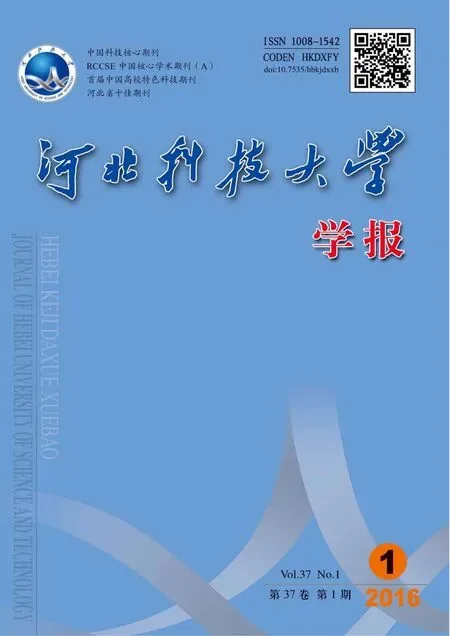工艺参数对半固态流变铸-锻6061合金成形性的影响
谭建波,杨 帅,李祎超
(1.河北科技大学材料科学与工程学院,河北石家庄 050018;2.河北省材料近净成形技术重点实验室,河北石家庄 050018)
工艺参数对半固态流变铸-锻6061合金成形性的影响
谭建波1,2,杨帅1,李祎超1
(1.河北科技大学材料科学与工程学院,河北石家庄050018;2.河北省材料近净成形技术重点实验室,河北石家庄 050018)
摘要:采用分析软件测定6061合金冷却曲线,用手工搅拌法制备半固态6061合金,制备不同温度下的水淬试样,测试了不同温度下的初生固相率。利用H1F100型伺服驱动压力机及杯型实验模具,进行半固态6061合金流变铸-锻成形,研究了合金温度、成形压力、上型温度、保持时间等工艺参数对半固态6061合金成形性的影响。结果表明:在一套模具内实现铸造和锻造是可行的,合金温度以及上型温度越高,制件的成形性越好。本实验条件下,当半固态合金温度为642~645 ℃、上型预热温度为200~300 ℃时,随着保持时间的增加,半固态6061合金铸-锻成形试样容易产生冷隔等铸造缺陷。
关键词:金属材料;流变铸-锻;6061合金;工艺参数;成形性
E-mail:tanjian1998@163.com
谭建波,杨帅,李祎超.工艺参数对半固态流变铸-锻6061合金成形性的影响[J].河北科技大学学报,2016,37(1):65-69.
随着交通运输业、武器装备业面向现代化、高速化方向的发展,以及世界各国对环境保护的重视程度越来越高,装备或产品的轻量化要求日趋强烈,尤其是对轻量化程度要求高的航天器、飞机、汽车、高速列车、坦克、火炮以及机械设备等重要受力部件和结构件,近几年来大量使用铝合金锻件和模锻件以代替原来的钢结构件[1],如飞机的一些结构件、汽车(特别是重型汽车和大中型客车)轮毂和底座大梁、坦克的负重轮及炮台机架等。而传统的模锻技术、铸锻一体化技术以及液态铸锻双控成形技术已不能完全满足这些铝合金关键零部件的制造需求和使用性能[2-3]。
半固态成形技术吸收了铸造和锻造的优点,被誉为“21世纪新的加工技术”[4-7]。但研究发现,许多合金在半固态铸造或锻造过程中出现了液相偏析,有学者使用建模和定量分析研究了半固态成形过程中的典型偏析现象[8-20],但至今没有找到有效的解决办法。本文采用半固态流变铸-锻成形,在一套模具内完成半固态铸造成形和半固态锻造成形,研究工艺参数对半固态流变铸-锻成形性的影响,探索半固态流变铸-锻的成形规律,旨在为以后进一步解决液相偏析现象提供参考。
1实验材料和方法
实验所用材料为棒材6061合金,主要成分为0.4%~0.8%(质量分数,下同)Si,0.15%~0.4%Cu,0.8%~1.2%Mg,余量为Al。实际测得合金的液相线为652 ℃,固相线为565 ℃,6061合金冷却曲线如图1所示。
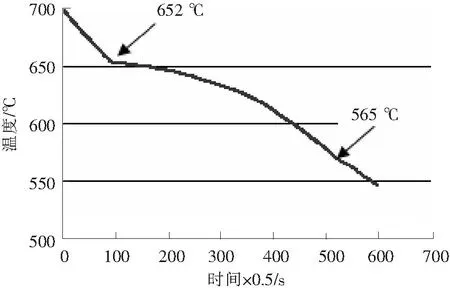
图1 6061合金冷却曲线Fig.1 Cooling curve of 6061 alloy
将6061合金棒材上切割一定尺寸的坯料,放入金属容器中,采用高频设备进行加热熔化至一定温度后,用捆有热电偶的细铁棍对金属液进行搅拌,在648,645,642,635 ℃时取出材料进行水淬,观察合金组织,如图2所示。经过分析,不同温度下的初生固相率如下:a)648 ℃,26%;b)645 ℃,38%;c)642 ℃,41%;d)635 ℃,55%。

图2 不同温度下的半固态合金组织Fig.2 Structures of semi-solid alloy under different temperatures
将6061合金棒材切割后放入实验模具的下型中(如图3所示,下型外径为40 mm、内径为32 mm、高60 mm,上型下部Φ22 mm,上部Φ32 mm),采用高频加热装置将切割的材料加热到720 ℃左右冷却,冷却过程中用捆有热电偶的钢棒进行搅拌,到设定温度后,放入成形设备中进行成形。成形设备为伺服驱动压力机H1F100,成形试样为杯型,如图4所示。半固态铸-锻成形时,上型向下移动,其移动轨迹如图5所示,即上型向下移动到预设位置后,上型保持位置不变,此阶段成形压力较小,成形压力充满型腔即可,此阶段为半固态流变铸造阶段。保持一定时间后,半固态合金温度降低,固相分数增加,然后上型继续向下移动,即在高压下进行凝固、塑性变形,此阶段为半固态锻造阶段。半固态铸造阶段,上型下行速度为30 mm/s,下型预热温度为350 ℃,其他半固态流变铸-锻成形参数见表1。
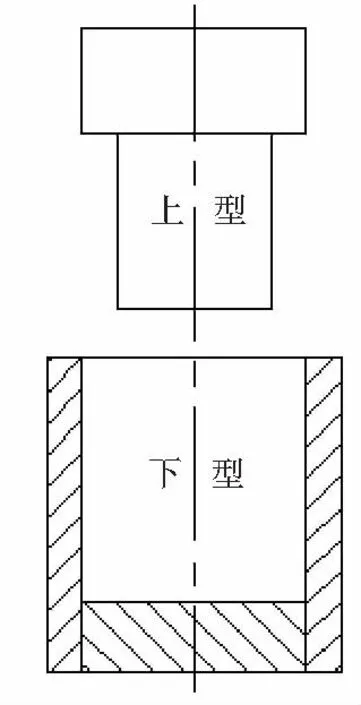
图3 实验模具Fig.3 Experimental mold
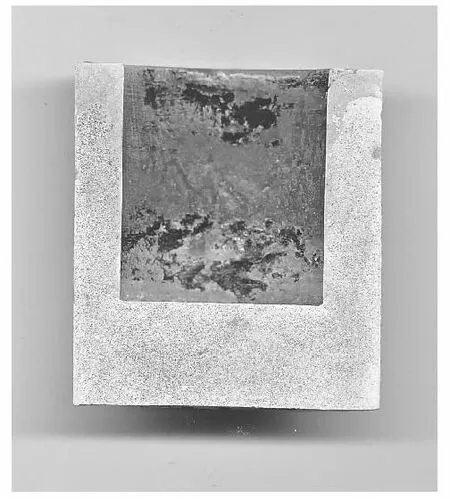
图4 试样断面Fig.4 Sample section
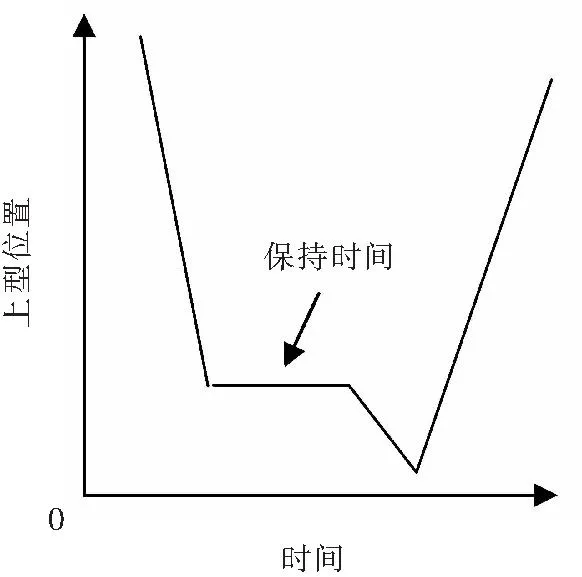
图5 上型移动轨迹Fig.5 Example of a mechanical servo press motion
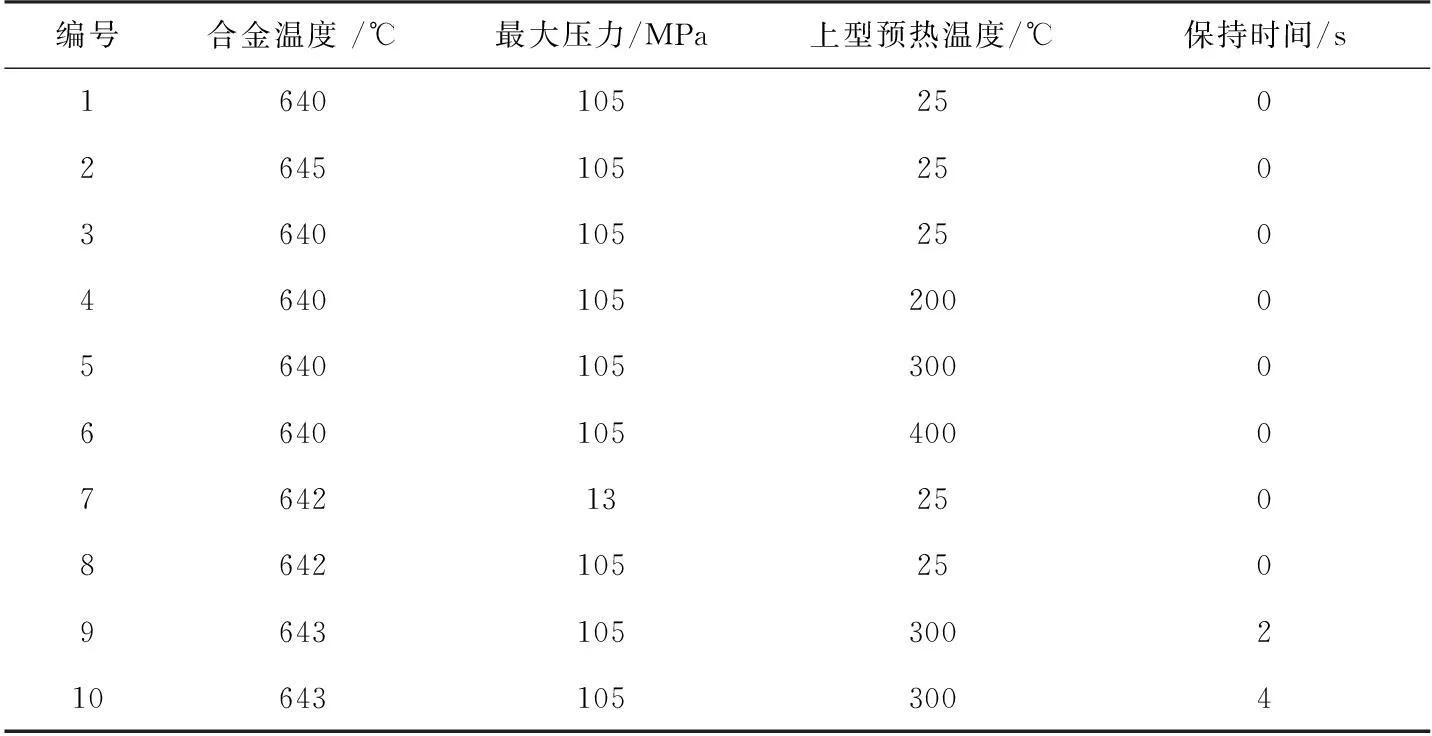
编号合金温度/℃最大压力/MPa上型预热温度/℃保持时间/s164010525026451052503640105250464010520005640105300066401054000764213250864210525096431053002106431053004
2结果与分析
2.1 温度对6061合金成形性的影响
图6为温度对6061合金成形性的影响。图6中编号1试样成形合金温度为640 ℃,试样中间部位出现了浇不足缺陷。编号2试样成形合金温度为645 ℃,试样基本完好,说明在上型温度为室温时,成形合金温度对试样的成形性影响较大。这是因为在其他参数相同的情况下,合金温度的高低决定成形合金中的初生固相率的多少,初生固相率和温度之间的函数关系如式(1)[21]所示。

图6 合金温度对6061合金成形性的影响Fig.6 Effects of alloy temperature on formability of 6061 alloy

(1)
式中:fs为固相率;T为合金温度,K;Tl为合金的液相线温度,K;Tm为纯溶剂的熔点温度,K; k0为溶质平衡分配系数;α为无量纲的溶质扩散因子。合金温度越高,初生固相率越少,越接近于液态成形。因此,温度高有利于试样成形。
2.2 上型温度对6061合金成形性的影响
图7为成形合金温度640 ℃,上型温度分别为室温和200,300,400 ℃时成形的试样。试样编号分别为3,4,5,6。由图7可以看出:编号3试样顶部未充满,试样中间存在浇不足和冷隔缺陷;编号4试样基本充满,但顶部存在冷隔现象;编号5和编号6试样轮廓清晰、完好。这说明上型预热温度对试样的成形性有较大影响。上型温度越高,合金冷却越慢,越有利于半固态合金的充型。但上型温度过高,制件冷却速度会过慢,容易产生晶粒粗大,造成制件性能下降。

图7 上型温度对6061合金成形性的影响Fig.7 Effects of upper die temperature on formability of 6061 alloy
2.3 成形压力对6061合金成形性的影响
图8为成形压力对6061合金成形性的影响。编号7试样成形压力较小,试样未充满,内部缺陷较多。随着压力的增大,试样基本充满,但由于上型温度为室温,成形合金温度为642 ℃,故试样上部也有铸造缺陷。
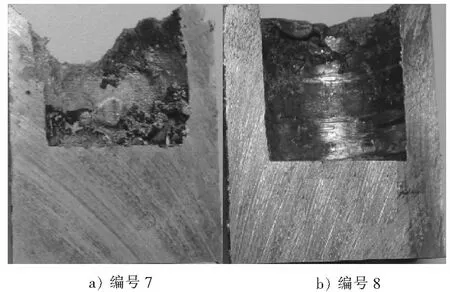
图8 成形压力对6061合金成形性的影响Fig.8 Effects of forming pressure on formability of 6061 alloy
2.4 保持时间对6061合金成形性的影响
图9为保持时间对6061合金成形性的影响。图9 a)为保持时间为2 s时成形的试样,图9 b)为保持时间为4 s时成形的试样。从外观上看,2个试样都已充满,但切开试样,观察内表面,发现2个试样都有缺陷,存在冷隔现象。
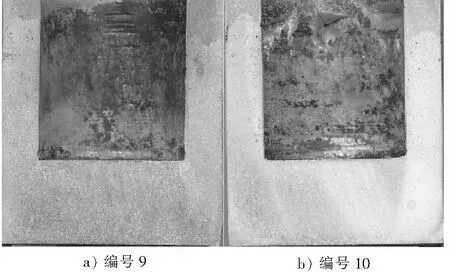
图9 保持时间对6061合金成形性的影响Fig.9 Effects of holding time on formability of 6061 alloy
编号9、编号10和编号5试样相比,成形时上型温度和比压相同,分别为300 ℃和105 MPa,且编号5试样成形合金温度较低(640 ℃),但编号5试样无论从外观、还是内表面,都没有缺陷。说明保持时间对合金的成形性影响较大。保持时间越长,合金的成形性就越差,这与一般实验规律相符。这是因为随着保持时间的增加,半固态合金在模具内的时间越长,由于这时试件还没有完全成型,合金冷却、凝固收缩得不到补缩时,就容易产生缩松、缩孔等缺陷;保持时间越长,试件也容易产生浇不足等缺陷。
3结论
1) 在一套模具内实现铸造和锻造是可行的。
2) 合金温度以及上型温度越高,制件的成形性越好。
3) 本实验条件下,当半固态合金温度为642~645 ℃,上型预热温度为200~300 ℃时,随着保持时间的增加,半固态6061合金铸-锻成形试样越容易产生冷隔等铸造缺陷。
参考文献/References:
[1]刘静安. 铝合金锻压生产现状及锻件的应用前景分析[J]. 轻合金加工技术, 2005,33(6):1-5.
LIU Jingan. Application foreground of forgings and states of aluminium alloy forging production[J]. Light Alloy Fabrication Technology, 2005,33(6):1-5.
[2]张长春, 孔维一, 胡凌云. 铸锻联合工艺生产农机复杂锻件的应用研究[J]. 农业机械学报, 1996,27(2):128-132.
ZHANG Changchun, KONG Weiyi, HU Lingyun. The research on the produced complex forging of agricultural machinery with cast- forging technology[J]. Transactions of the Chinese Society for Agricultural Machinery, 1996,27(2):128-132.
[3]李远发, 苏平线. 液态压铸锻造双控成形技术研究[J]. 特种铸造及有色合金, 2006,26(9):568-571.
LI Yuanfa, SU Pingxian. Double-control formation technology of liquid-squee-zing-forging[J]. Special Casting & Nonferrous Alloys, 2006,26(9):568-571.
[4]张俊杰. 半固态铝合金流变压铸充型及凝固过程数值模拟[D]. 石家庄: 河北科技大学,2012.
ZHANG Junjie. The Numerical Simulation of Rheodiecasting Process of Filling and Solidification of Semisolid Aluminum Alloy[D].Shijiazhuang: Hebei University of Science and Technology, 2012.
[5]ZHOU Bing, KANG Yonglin, ZHU Guoming,et al. Forced convection rheoforming process for preparation of 7075 aluminum alloy semisolid slurry and its numerical simulation[J]. Transactions of Nonferrous Metals Society of China, 2014,24(4) :1109-1116.
[6]谭建波, 刘冉, 郝跃光. 充型速度对半固态AlSi9Mg组织及性能的影响[J]. 河北科技大学学报, 2011,32(2):173-176.
TAN Jianbo, LIU Ran, HAO Yueguang. Influence of filling velocity on semi-solid microstructures and properties of AlSi9Mg alloy[J]. Journal of Hebei University of Science and Technology, 2011,32(2):173-176.
[7]谭建波, 李增民, 李立新, 等. 浇注长度对流变压铸AlSi9Mg组织及性能的影响[J]. 河北科技大学学报, 2010,31(6):568-571.
TAN Jianbo, LI Zengmin, LI Lixin, et al. Influence of pouring length on rheo-die casting microstructures and properties of AlSi9Mg[J]. Journal of Hebei University of Science and Technology, 2010,31(6):568-571.
[8]NOLL T,FRIEDRICH B,HUFSCHMIDT M.Evaluation and modelling of chemical segregation effects for thixoforming processing[J].Adv Eng Mater,2003,5(3):156-160.
[9]KANG C G,JUNGIALS H K.A study on solutions for avoiding liquid segregation phenomena in thixoforming process:Constitutive modelling and finite element method simulations for die design[J].Metall Mater Trans B,2001,32(1):119-127.
[10]HUFSCHMIDT M,MODIGELL M,PETERA J.Modelling and simulation of forming processes of metallic suspensions under non-isothermal conditions[J].Journal of Non Newtonian Fluid Mechanics,2006,134(1/2/3):16-26.
[11]SEO P K,KIM D U,KANG C G.The effect of the gate shape on the microstructural characteristic of the grain size of Al-Si alloy in the semi-solid die casting process[J].Mater Sci Eng A,2007, 445/446:20-30.
[12]MÖLLER H, CURLE U A, MASUKU E P. Characterization of surface liquid segregation in SSM-HPDC aluminium alloys 7075,2024,6082 and A201[J].Transactions of Nonferrous Metals Society of China,2010,20(3):847-851.
[13]GOVENDER G, MÖLLER H. Evaluation of surface chemical segregation of semi-solid metal cast aluminium alloy A356[J].Solid State Phenomena,2008,141/142/143:433-438.
[14]LIU D, ATKINSON H V, KAPRANOS P, et al. Effect of heat treatment on structure and properties of thixoformed wrought alloy[C]//Proceedings of the 7th International Conference on Semi-Solid Processing of Alloys and Composites.Tokyo:[s.n.],2002:435-437.
[15]KANG C G, LEE S M.The effect of forging pressure on liquid segregation during direct rheoforging process of wrought aluminium alloys fabricated by electromagnetic stirring[J].Journal of Engineering Manufacture,2008,222(12):1673-1684.
[16]VIEIRA E A, FERRANTE M. Prediction of rheological behaviour and segregation susceptibility of semi-solid aluminium-silicon alloys by a simple back extrusion test[J].Acta Mater,2005, 53(20):5379-5386.
[17]YOSHIDA C, MORITAKA M, SHINYA S, et al. Semisolid forging of aluminum alloys[C]//Proceedings of the 2nd International Conference on Semi-Solid Processing of Alloys and Composites.New York:[s.n.],1992:274-280.
[18]LOUE W R, SUERY M, QUERBES J L. Microstructure and rheology of partially remelted A1Si-alloys[C]//Proceedings of the 2nd International Conference on Semi Solid Processing of Alloys and Composites.New York:[s.n.],1992:534-549.
[19]CHO W G, KANG C G.Mechanical properties and their microstructure evaluation in the thixoforming process of semi-solid aluminum alloys[J].J Mater Process Technol,2000,105(3): 269-277.
[20]谭建波,王子超,王东旭.杯形件半固态模锻充型过程模拟及实验验证[J].河北科技大学学报,2015,36(3):313-318.
TAN Jianbo,WANG Zichao,WANG Dongxu.Scmulation and experimental verification of the filling process of semi-solid die forging for cup shell[J].Journal of Hebei University of Science and Technology,2015,36(3):313-318.
[21]胡汉起.金属凝固原理[M].北京:机械工业出版社,2000.
TAN Jianbo,YANG Shuai,LI Yichao.Effect of technological parameters on formability of semi-solid rheological casting-forging 6061 alloy[J].Journal of Hebei University of Science and Technology,2016,37(1):65-69.
Effect of technological parameters on formability of semi-solid rheological casting-forging 6061 alloy
TAN Jianbo1,2, YANG Shuai1, LI Yichao1
(1.School of Material Science and Engineering, Hebei University of Science and Technology, Shijiazhuang, Hebei 050018, China; 2.Hebei Key Laboratory of Material Near-net Forming Technology, Shijiazhuang, Hebei 050018, China)
Abstract:The 6061 alloy cooling curve is determined by analysis software, and the 6061 semi-solid alloy is prepared by manual paddling process. The primary solid fraction is tested through prepared water quenched samples under different temperature. With H1F100 type servo press and cup type test mold, the forming of the 6061 semi-solid alloy rheological casting-forging is made. The influence of alloy temperature, forming pressure, upper mould temperature and holding time on the formability of 6061 alloy is researched. The results show that within the same set of mold completing casting and forging of the alloy is feasible. Along with the increase of the alloy temperature and the upper mould temperature, the formability of finished products becomes better. Under this experimentation, when the temperature of the semi-solid alloy is amongst 642 ℃ to 645 ℃ and the upper mould preheating temperature is amongst 200 ℃ to 300 ℃, casting defects such as cold insulation will form in the casting-forging sample of semi-solid 6061 alloy with the prolongation of holding time.
Keywords:metal material;rheological casting-forging; 6061 alloy; process parameters; formability
作者简介:谭建波(1964—),男,河北定州人,教授,博士,主要从事半固态成形技术与理论方面的研究。
基金项目:河北省自然科学基金(E2014208087);河北省引进留学人员资助项目(C201400515)
收稿日期:2014-12-06;修回日期:2015-04-31;责任编辑:张士莹
中图分类号:TG146.4
文献标志码:A
doi:10.7535/hbkd.2016yx01011
文章编号:1008-1542(2016)01-0065-05

